The maritime industry is exploring new frontiers, and Large Format Additive Manufacturing (LFAM) is making waves. Imagine a factory where durable, low-maintenance High-Density Polyethylene (HDPE) boats are 3D printed using advanced robotic systems. Our recent analysis dives into the feasibility of just such a venture, specifically leveraging CEAD Group’s robotic arm technology (Flexbot).
Why HDPE? Why 3D Printing?
HDPE is already valued in workboats and utility vessels for its incredible toughness, inherent buoyancy, zero corrosion, and minimal upkeep. Combining this robust material with LFAM offers tantalizing possibilities:
Unprecedented Design Freedom: Create complex hull shapes and integrated features without traditional molds.
Automation & Efficiency: Potential to reduce labor costs and shorten production lead times.
Sustainability: Leverage HDPE’s recyclability and minimize waste compared to subtractive methods.
Customization: Offer tailored solutions more rapidly.
Navigating the Challenges: While the potential is immense, the journey isn’t without obstacles:
The HDPE Hurdle
Printing large HDPE structures is notoriously difficult due to significant warping and adhesion challenges. Success hinges on specialized materials (like CEAD’s optimized HDPE ) and precise process control, especially thermal management – a key consideration for open robotic cells.
Structural Integrity: Ensuring robust layer bonding and overall structural soundness equivalent to traditional methods is paramount.
Economic Viability: High initial investment in LFAM systems requires high utilization and a strong market strategy to compete effectively.
Regulatory Waters: Demonstrating compliance with maritime standards (like CE marking in Europe ) for a novel manufacturing process requires rigorous testing and documentation.
Companies like CEAD are tackling these challenges head-on, developing specialized robotic systems (Flexbot), optimized HDPE materials, and dedicated maritime application centers (MAC) to prove the concept. Projects like their 6m HDPE prototype and the large ferry demonstrate capability at scale.
3D printing HDPE boats with robotics is technically feasible but demands significant expertise in materials science, process engineering, and quality control. It represents a bold step towards a more automated, customizable, and potentially sustainable future for boat manufacturing. Mastering the process and navigating the regulatory landscape will be key to unlocking this technology’s full potential.
What are your thoughts on the future of 3D printing in the maritime sector?
#3DPrinting #AdditiveManufacturing #LFAM #Maritime #BoatBuilding #Shipbuilding #HDPE #Robotics #Automation #Innovation #Sustainability #CEAD #Manufacturing #Engineering

